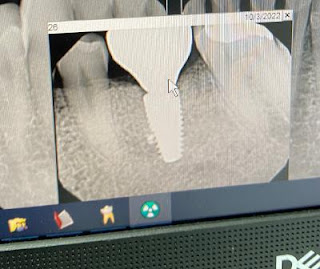What is emergence profile and why it can be important to implant restorations?
 |
| Screw retained implant restoration with properly shaped emergence profile |
The angle and the shape of the abutment or screw retained crown should be flare slowly and be concave if possible. This shape will not press on adjacent bone and tissue that will support the implant restoration. This should minimize inflammation and facilitate the dentists ability to full seat and torque down the implant restoration. A properly designed restoration is kinder to the surrounding tissues and may make their continued health and preservation more likely as well as facilitate proper cleansabilty by the patient.
Often times these restorations are designed by technicians who don't always understand the principles involved with proper perio prosthodontic design. The photo below shows an area about one mm away from the platform switch implant where the interface has a small ledge that brings it closer to the osseous interproximal bone. This is usually correctable by carefully using rotary abrasives to fix the poorly shaped area. While these restorations may work out ok, its clearly better to make the emergence profile with a concave or flat emergence profile and a smooth transition from titanium to ziconium interface ( assuming the restoration is not a ceramometal restoration). Under a close examination of this photo you can see that the mesial proximal bone is probably covering part of the implant head so a convex emergence profile may actually be pressing on the proximal bone. Even though this restoration was fully seated, it is possible that it is pressing on the proximal bone or associated soft tissue covering. Clearly it would be better if it had a smooth concave shape that would place the area further away from the proximal tissues.
from Ask Dr. Spindel - http://lspindelnycdds.blogspot.com/2022/10/what-is-emergence-profile-and-why-it.html - http://lspindelnycdds.blogspot.com/
.jpg)

Comments
Post a Comment